Silicon Oxide & Graphene Create Vision Memory

Researchers at Rice University are designing transparent, two-terminal, three-dimensional computer memories on flexible sheets.
This development shows promise for electronics and sophisticated heads-up displays.
The technique originally developed by Rice University in 2008, was based on the switching properties of silicon oxide, which was reported in the online journal Nature Communications.
The Rice team led by chemist James Tour and physicist Douglas Natelson is making highly transparent, non volatile resistive memory devices based on the revelation that silicon oxide itself can be a switch.
A voltage run across a thin sheet of silicon oxide strips oxygen atoms away from a channel 5 nanometres wide, turning it into conductive metallic silicon. With lower voltages, the channel can then be broken and repaired repeatedly, over thousands of cycles.
That channel can be read as a "1" or a "0," which is a switch, the basic unit of computer memories.
At 5 nm, the technolgy shows promise to extend Moore's Law, which predicted computer circuitry will double in power every two years. Current state-of-the-art electronics are made with 22 nm circuits.
The research details memories that are 95 percent transparent, made of silicon oxide and crossbar graphene terminals on flexible plastic.
"The Rice lab is making its devices with a working yield of about 80 percent, "which is pretty good for a non-industrial lab," Tour says. "When you get these ideas into industries' hands, they really sharpen it up from there."
Manufacturers who have been able to fit millions of bits on small devices like flash memories now find themselves bumping against the physical limits of their current architectures, which require three terminals for each bit.
But the Rice unit, requiring only two terminals, makes it far less complicated. It means arrays of two-terminal memories can be stacked in three-dimensional configurations, vastly increasing the amount of information a memory chip might hold. Tour said his lab has also seen promise for making multi-state memories that would further increase their capacity.
The image above shows graphene as crossbar terminals, Rice University researchers are following through on research that shows silicon oxide, one of the most common materials on Earth, can be used as a reliable computer memory. The memories are flexible, transparent and can be built in 3-D configurations.
Yao's discovery followed work at Rice on graphitic-based memories in which researchers saw strips of graphite on a silicon oxide substrate break and heal when voltage was applied. Yao suspected the underlying silicon oxide was actually responsible, and he struggled to convince his lab colleagues.
"Jun quietly continued his work and stacked up evidence, eventually building a working device with no graphite," Tour continues. "And still, others said, 'Oh, it was exogenous carbon in the system that did it!' Then he built it with no exposure to carbon on the chip."
Yao's revelation became the basis for the next-generation memories being designed in Tour's lab, where the team is building memories out of silicon oxides sandwiched between graphene - one-atom-thick ribbons of carbon "“ and attached to plastic sheets. There's not a speck of metal in the entire unit (with the exception of leads attached to the graphene electrodes).
































